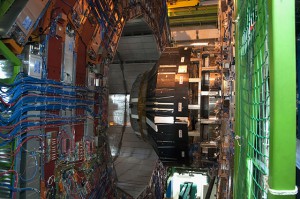Courtesy of CERN
Detectors exploring subatomic collisions at CERN kept pace with pile up through recent runs of the world’s largest particle accelerator. Upgrades will allow tigger systems to double the number of pile up events they can investigate in a search for clues about the universe.
BY STEPHANIE SUNATA
DEC 19, 2013
The world’s largest circular particle accelerator – the Large Hadron Collider at CERN – creates hundreds of millions of subatomic collisions per second in an odyssey to unravel mysteries of the universe. The collisions helped scientists discover the Higgs boson, part of the mechanism that gives mass to fundamental particles that make up matter.
Now the accelerator is taking a break from collisions until 2015 for upgrades that will boost the collision energy and rate of collisions. While this will help scientists in their search for new horizons, such as the elusive dark matter of the universe, more collisions means more pile up.

Stephanie Sunata/MEDILL
Particle detectors such as the CMS at CERN search through the subatomic debris of near light-speed collisions to unravel secrets of the universe. The end-cap of the CMS detector is exposed here as the instrument gets upgrades. The CMS is one of two at CERN’S Large Hadron Collider that scientists used to find the elusive Higgs boson.
Pile up at the LHC is much like pile up on a highway and can hinder the search for rare events that could help scientists in their explorations. The detectors incorporate trigger systems that sort through every collision to determine which ones are interesting. But the trigger systems can only work so fast before the collisions begin to pile up. If the pile up gets too overwhelming, that set of data could be dumped and scientists lose the chance to analyze it.
So the experimenters at the LHC are taking this time to upgrade their instruments, including improvements to the trigger systems.The LHC accelerates particles near the speed of light around a 17-mile ring, then slams them together at unprecedented energies. Scientists study the debris to answer questions about how the universe works.
The LHC’s largest experiments, ATLAS and CMS, kept the pace with the pile up in the first phase of LHC operation. In a specialized pile up run, the CMS detector was able to handle more than 70 pile up events. Scientists and engineers are now planning on ways to deal with more than 100 pile up events.
The LHC’s first run culminated with the announcement that both experiments independently found the Higgs boson that scientists had hunted for decades. The discovery led to this year’s Nobel Prize in physics, which was awarded to two of the men whose theories sparked the search for the particle—Francois Englert and Peter Higgs.
James Hirschauer worked on the CMS experiment and said finding the Higgs was like a baseball team winning a division title. It’s a big milestone, but there are still important games to play. In particle physics, this means there are still a lot of questions that need to be answered and it’s not clear if the questions will end.
“With basic research, you don’t know,” he said. “It’s like the playoffs go on forever. You don’t know if there is a World Series.”
But Hirschauer and others at CERN are excited for what lies ahead. Many particle physicists are now focusing on dark matter. This phenomenon has gravitational effects like ordinary matter, but it doesn’t emit or absorb light, so it has been difficult to detect.
While cosmologists are able to observe the effects of the pull of dark matter, little is known about what it is exactly. Stephen Sekula, a physicist on the ATLAS experiment, said some theorize it is a particle. If this is the case, scientists at the LHC could discover it.
“One of the things that we hope is that if it’s out there in the cosmos, we can make it in here in the laboratory,” Sekula said.
If there is a dark matter particle, it won’t be easy to find. The upgrades to the LHC and the detectors will improve the instruments and could get scientists one step closer to answers about dark matter, and help us understand how our universe works.
This story was made possible in part by a grant from Carnegie Corporation of New York. The statements made and views expressed are solely the responsibility of the author.